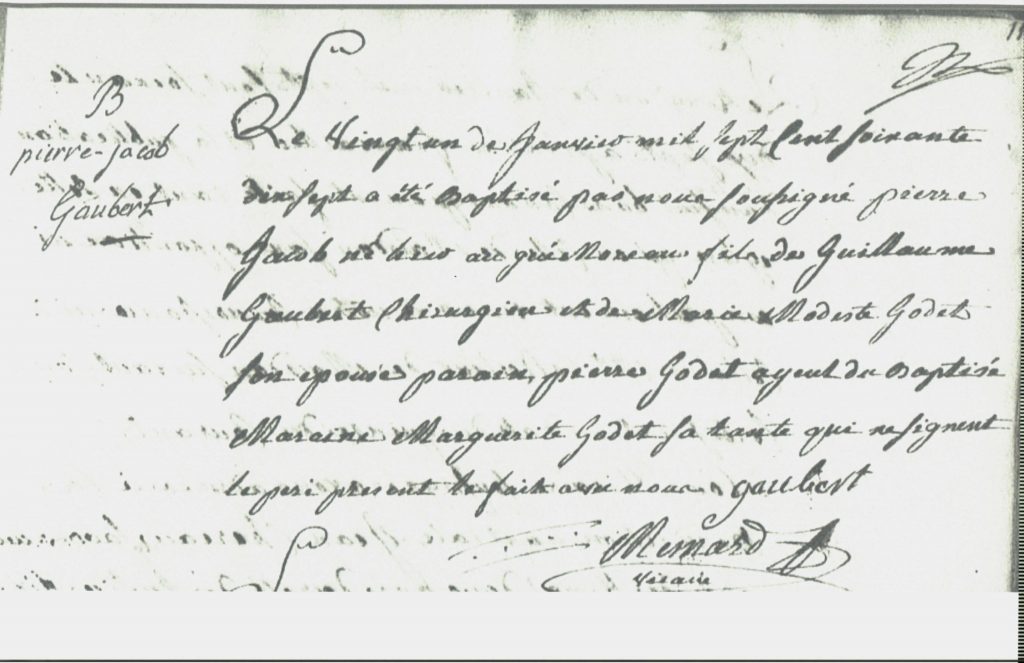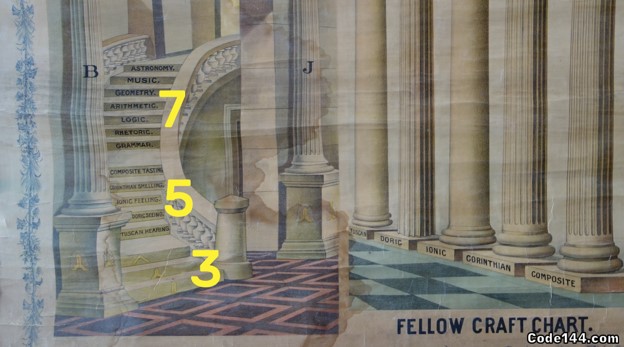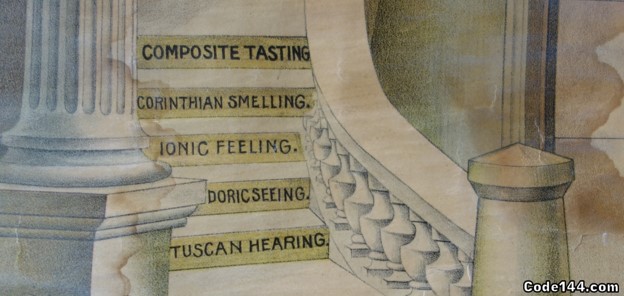It’s pretty interesting how conducting research on your family can produce all kinds of new and interesting subjects…issues you probably never thought would have an impact on your research.
I possessed the baptismal record for my paternal 4th great grandfather, Pierre Jacob Gaubert, for at least a couple of years before I paid attention to a symbol preceding the Vicar’s signature. I had not paid any attention to it before because I was so thrilled to have the document! The symbol is two parallel lines with five dots evenly spaced in line within the two lines. This baptismal document is from 1777 in Nantes, France. When I shared the baptismal record with a friend who is very knowledgeable about French documents I was informed that it is a Masonic symbol. Not thinking much more about it at the time I moved on to other things.

Pierre Jacob Gaubert baptism Nantes, France 1777
Trans: The twenty first of January one thousand seven hundred seventy seven was baptized by me the undersigned Pierre Jacob son of Guillaume Gaubert surgeon and of Marie Modeste Godet his wife godfather Pierre Godet [having or holding] the child godmother Marguerite Godet his aunt who declared not to know how to sign the father knowing how the fact with us Gaubert [sig]
Mainard Vicar [sig]
In September 2019 at the annual meeting of Le Comité des Archives de la Louisiane — the non-profit genealogical support group for the Louisiana State Archives — Sally Sinor, at the time an Archivist at the New Orleans Notarial Archives, presented “Looking Into the Lodge,” her talk about Louisiana Freemasonry. She spoke at length on the history of Freemasonry’s origin in Scotland and its development in England and France. Most do not know what Freemasonry is but, suffice it to say, there is a lot of ritual, symbolism and signs. (See our post “Masonic Ceremony” September 16, 2012 for more information.) I shared my document with Ms. Sinor and she confirmed that, yes indeed, it is a Freemason symbol on my ancestor’s baptismal next to the Vicar’s name. I could not understand how/why a Catholic priest would be a Freemason and why he would indicate it on my ancestor’s baptism record.
Freemasonry and Fellowcraft
Caveat: I am not a scholar of Freemasonry and am presenting what knowledge I have gained through research of the Craft–knowing that it is much more involved than what I write here–so our readers can understand how I arrived at my conclusion.
Masonry can be traced to the word mason to the French maçon (Latin matio or machio), “a builder of walls” or “a stone-cutter.” The term Freemason has a long history most likely from 1155 designating primarily a mason of superior skill, though later it was also designated as one who enjoyed the freedom, or the privilege, of a trade guild. The term “free” possibly pertaining to stone masons as skilled artisans who were free of the guilds. These free masons formed a universal craft for themselves, with a system of secret signs and passwords by which a craftsman, who had been admitted on giving evidence of competent skill, could be recognized.
Now, Freemasonry or Masonry consists of fraternal organizations that trace their origins to the local fraternities of stonemasons that from the end of the fourteenth century regulated the qualifications of stonemasons and their interaction with authorities and clients. The degrees of Freemasonry retain the three grades of medieval craft guilds, those of Apprentice, Journeyman or Fellow (now called Fellowcraft), and Master Mason. The candidate of these three degrees is progressively taught the meanings of the symbols of Freemasonry, and entrusted with grips, signs and words to signify to other members that he has been so initiated. Three degrees are offered by Craft Freemasonry, and members of any of these degrees are known as Freemasons or Masons. There are additional degrees, which vary with locality and jurisdiction, and are usually administered by their own bodies (separate from those who administer the Craft degrees).
The basic, local organizational unit of Freemasonry is the Lodge. These private Lodges are usually supervised at the regional level… by a Grand Lodge or Grand Orient. There is no international, worldwide Grand Lodge that supervises all of Freemasonry; each Grand Lodge is independent, and they do not necessarily recognize each other as being legitimate.
Researching and understanding what is meant by “Fellowcraft” would take me closer to an understanding of what the symbol or sign on my 5th great grandfather’s baptism meant and why it would be associated with a Vicaire in the ancien regime of France.
Fellowcraft is the second degree of Freemasonry or someone who has taken the degree of Fellowcraft.
Within the Fellowcraft Degree are three jewels which are: attentive ear, instructive tongue, and faithful breast. The teaching is that: 1) In learning and education, we must listen if the work is to be properly transmitted from generation to generation. The life of Freemasonry depends on ears that are attentive, 2) An instructive tongue is necessary in order that knowledge be conveyed accurately. But the tongue teaches more than ritual. It informs Masons of the great truths and symbolism in Masonry. That makes good men better men and 3) The faithful breast is the repository for those few secrets entrusted to Masons as they progress through the three degrees in Masonry. It is also the repository of those ideals Masons should display in life and pass on, that others may learn and grow to be better men. The Degree of Fellowcraft emphasizes the dignity and worth of the individual…that Man should be an instrument of the Supreme Architect of the Universe. This approach can be seductive and it is understandable why many men might be induced to follow such teachings.
This particular symbol
The numbers 3, 5 and 7 are significant in the Craft, as is evident from the…manner in which these numbers are brought to the attention of a Fellowcraft Mason during the ritual of the Degree. The Fellowcraft Degree relates sequences of 3, 5 and 7 steps:
 The first three steps are related to the first 3 degrees of Freemasonry.
The first three steps are related to the first 3 degrees of Freemasonry.
The next five steps are related to the senses and the 5 orders or architectural columns:

The seven steps are related to the liberal arts and sciences.
In my search for what the sign of five dots between parallel lines means, I believe they designate Vicaire Mainard as someone who has achieved the second order of 5 steps of Freemasonry.
Catholic Clergy as Freemasons?
According to the Grand Lodge of British Columbia and Yukon, Masonic lodges [in France] were first warranted in…1725. Prior to the revolutionary period there were 1,250 lodges in France with an estimated 40,000 members. French Freemasonry of the 18th century was an exclusive group…The clergy were well represented, and the membership of some lodges, such as La Vertu in Clervaux, were composed entirely of Catholic clergymen.
I have concluded that when my 4th great grandfather, Pierre Jacob Gaubert was baptized in 1777 the Catholic clergy was well entrenched in Freemasonry–its ideas appealed to them and obviously held no conflict with their religious beliefs–therefore Vicaire Mainard was proud to include the sign of 5 dots within parallel lines with his signature.

If anyone has found any such similar symbolism on their documents you may be interested that Sally Sinor shared that she plans to give another talk in February 2020 at the Cabildo in New Orleans on the Grand Lodge of France (Grande Loge de France) and its successor, the Grand Orient of France, the Masonic Lodge founded in France in 1773 (generally considered to be the mother lodge of traditional Liberal, or Continental Freemasonry) and which was influential on the French lodges in Louisiana.
Lenora Gobert
Sources: Pierre Jacob Gaubert bapt 1777, Registres paroissiaux et d’état civil AD44 ETAT-CIVIL; http://www.newadvent.org/cathen/09771a.htm; https://en.wikipedia.org/wiki/Freemasonry; https://en.wikipedia.org/wiki/Grand_Orient_de_France; https://www.merriam-webster.com/dictionary/fellowcraft; https://www.masonicworld.com/education/articles/THE-FELLOW-CRAFT-DEGREE.htm ; A Proof of Euclid’s 47th Proposition Using Circles Having the Proportions of 3,5, and 7, http://www.freemasons-freemasonry.com/euclid_proposition_circles.html; http://www.code144.com/tech/masonic-3-5-7-steps; https://freemasonry.bcy.ca/texts/revolution.html



What excellent information! A mystery that I heard about all my life. Is that the origin of the “Masons”, that Black people are affiliated with?
Yes, I believe so. Please read our associated article that I referenced as it is a bit about the black Masons. They had to start their own organizations because of racism and segregation, as you know.
I am looking for information about my great-grandfather – an Episcopal priest with a doctorate from Philips University/Philips Seminary which is still in existence. How did a Blackfeet Indian with a white wife find that path to ordination. How did his wife play tennis in an exclusive white tennis club not far from the rectory of St. Luke’s Episcopal Church. The rectory was on Carrollton Street at the time. I have pictures of her at the tennis club in tennis outfit with her daughter. She was clearly, white – at a time when interracial marriages were illegal in the south. Her daughter was clearly minority, but she is also in tennis outfits at the same club. The way racism worked and works in the south will never stop amazing me.
Thank you for sharing your history and excellent information.
Creolegen.org is a gift to the world! Thank you.
I had an uncle who was a member of a ‘masonic lodge’ in New Orleans way back when ….early 1950s. He was also a Catholic and as family lore told, was not supposed to belong to the Masons. He was proud of both his affiliations. By trade he was a master carpenter.
Lenora, another piece of your wonderful and diligent research! Thank you for sharing.
I also am not a scholar of Masonry. I recommend Caryn Cosse Bell’s work on Pere Antoine in which she discusses, briefly, Jansenism.
The Jansenists, within the Catholic Church during the times you mention, were at war ideologically with the Jesuits and were instrumental in having them kicked out of the New World.
The Jansenist effort was embraced by Portuguese and then Spanish merchant forces who objected to the Jesuit attempts to protect indigenous populations from enslavement, which threatened the economic model.
All of these pieces interlace and nothing is ‘as it seems’ as evidenced by the Church and its quixotic relationship with Masonry in the ‘new’ world.
Thanks for opening a window to let some sunlight in!
–Fernin
Interesting read. I am trying to learn if Louis Andre Martinet was a Freemason in New Orleans. Is there someplace I can go online or call to find out if he was a member of a lodge for people of color in New Orleans?
Would Freemason records indicate where Louis Andre Martinet was buried? I seem to remember that when my Grandfather died there was a masonic ceremony of some kind next to his grave. I haven’t been able to find out where Louis Andre Martinet was buried.
Thanks!
Historian Judith “Judy” Bethea did extensive research on Martinet prior to her death. Her research material is at the New Orleans Public Library’s Louisiana Division. http://archives.nolalibrary.org/~nopl/mss/jlbethea.htm
One of her goals was to find out where he is buried. I do not know if she succeeded or not, but her research material would document the steps she took.
I have run across some of her work on line. As far as I know she never found where he was buried but the last information I have seen by her was written while she was alive.
Sounds like I need to visit the New Orleans Public Library!